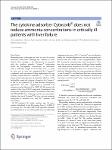Item Infomation
Full metadata record
| DC Field | Value | Language |
|---|---|---|
| dc.contributor.author | Uwe, Liebchen | - |
| dc.contributor.author | Michael, Paal | - |
| dc.contributor.author | Caroline, Gräfe | - |
| dc.date.accessioned | 2023-03-20T07:23:25Z | - |
| dc.date.available | 2023-03-20T07:23:25Z | - |
| dc.date.issued | 2023 | - |
| dc.identifier.uri | https://link.springer.com/article/10.1007/s00134-023-06998-w | - |
| dc.identifier.uri | https://dlib.phenikaa-uni.edu.vn/handle/PNK/6991 | - |
| dc.description | CC BY | vi |
| dc.description.abstract | Hemadsorption techniques are used in critical care for numerous indications, although the evidence is often limited. One example is the elimination of ammonia with the cytokine adsorber Cytosorb® (adsorption based on hydrophobic interactions of substances with a molecular weight of 5–55 kDa). Most recently, in vitro and in vivo data postulated that Cytosorb® (combined with continuous kidney replacement therapy (CKRT)) could eliminate ammonia [1, 2]. | vi |
| dc.language.iso | en | vi |
| dc.publisher | Springer | vi |
| dc.subject | cytokine adsorber Cytosorb® | vi |
| dc.subject | continuous kidney replacement therapy | vi |
| dc.title | The cytokine adsorber Cytosorb® does not reduce ammonia concentrations in critically ill patients with liver failure | vi |
| dc.type | Book | vi |
| Appears in Collections | ||
| OER- Y học- Điều dưỡng | ||
Files in This Item:

